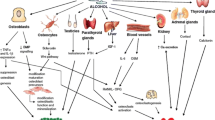Abstract.
The purpose of this study was to determine the prevalence of osteoporosis, to estimate the bone turnover and hormonal status, and to identify the factors associated with bone disease in patients with end-stage liver disease who were referred for orthotopic liver transplantation.
A prospective study was performed on 58 cirrhotic patients (6 with primary biliary cirrhosis, 14 with alcoholic cirrhosis, and 38 with posthepatitic cirrhosis), who were referred for orthotopic liver transplantation. Patients, excluding those with primary biliary cirrhosis, were classified in Child-Pugh groups according to the severity of liver disease (class B [28 patients], class C [24 patients]). Biochemical parameters of bone mineral metabolism and standard liver function tests were measured in all patients. Additionally, serum osteocalcin, urinary hydroxyproline/creatinine ratio, serum intact parathyroid hormone, serum 25-hydroxyvitamin D, serum 1,25-dihydroxyvitamin D, folliclestimulating hormone, and luteinizing hormone levels were determined in patients and controls within the same age range. Plasma testosterone, sex hormone-binding globulin levels, and free testosterone index were obtained for all men included in the study.
Bone mass of the lumbar spine and femur were measured by dual X-ray absorptiometry (DPX-L), and were expressed as a standard deviation of mean values (Z-score) from a sex and age-matched control group. Spinal X-rays were obtained to assess vertebral fractures. Osteoporosis was considered as a factor in spinal bone mineral density with a Z-score below 2 or at least one vertebral fracture.
Twenty-five patients (43%) had osteoporosis, with lower bone mass measurements in the lumbar spine than in the femoral neck (P < 0.005). Alcoholic and Child-Pugh C patients showed the lowest femoral bone mineral density values. Cirrhotic patients showed lower osteocalcin levels than controls (14.3 ± 5.9 vs. 18.2 ± 8.1 ng/ml; P < 0.05) and showed increased urinary hydroxyproline (125.1 ± 51.5 vs. 107.9 ± 26.6 nM/mg creatinine; P < 0.05). Serum 25-hydroxyvitamin D, 1,25-dihydroxyvitamin D and parathyroid hormone levels were significantly lower in cirrhotic patients than in controls (10.3 ± 9.1 vs. 23.1 ± 26.6 ng/ml; P= 0.000), (12.9 ± 9.1 vs. 48.3 ± 11.5 pg/ml; P= 0.000), (16.6 ± 9.2 vs. 27.9 ± 8.2 pg/ml; P= 0.000), with no differences between Child-Pugh groups. Alcoholic Child-Pugh C patients showed the lowest 25-hydroxyvitamin D serum values (4.5 ± 2.2 ng/ml; P < 0.05). Male patients had lower testosterone levels than controls (302.5 ± 229.4 vs. 556.7 ± 146.5 ng/dl; P= 0.000), with increased sex hormone-binding globulin values. Levels of testosterone and gonadotropin were related to Child-Pugh classification. No correlation was found between bone mass and hormonal values.
A significant decrease in bone mass, particularly in the lumbar spine, is seen in end-stage cirrhotic patients. Reduced bone formation and significant disorders of bone mineral metabolism, such as vitamin D deficiency, reduced parathyroid hormone levels, and hypogonadism are involved. Moreover, severity and etiology of the liver disease are the main risk factors for developing bone loss and mineral metabolism disorders in patients referred for orthotopic liver transplantation.
Similar content being viewed by others
Author information
Authors and Affiliations
Additional information
Received: 7 March 1996 / Accepted: 24 June 1996
Rights and permissions
About this article
Cite this article
Monegal, A., Navasa, M., Guañabens, N. et al. Osteoporosis and Bone Mineral Metabolism Disorders in Cirrhotic Patients Referred for Orthotopic Liver Transplantation. Calcif Tissue Int 60, 148–154 (1997). https://doi.org/10.1007/s002239900205
Published:
Issue Date:
DOI: https://doi.org/10.1007/s002239900205




